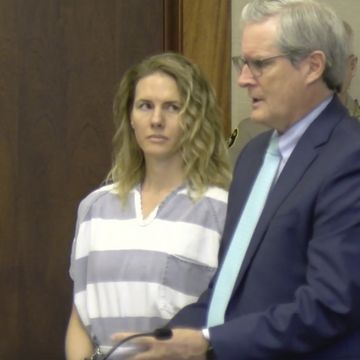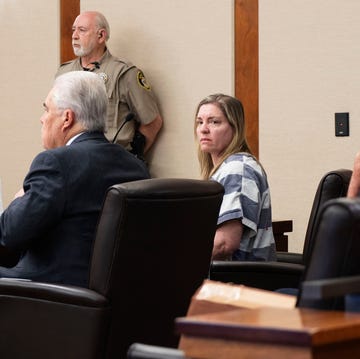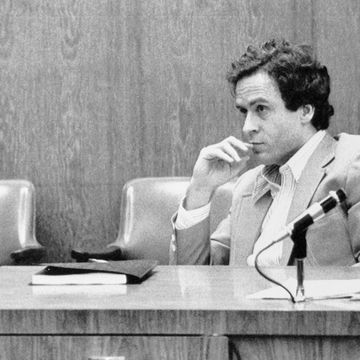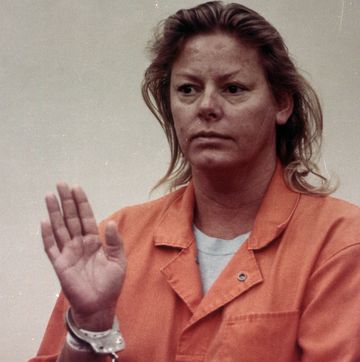Cults have long been a point of morbid fascination in the human psyche due to the seemingly inexplicable power some people are so easily able to exert over others. Many cults are based in radicalized religious beliefs and headed by self-professed deity-like figures who make bold claims such as having a direct line to God or being privy to a looming apocalypse of mass proportions that never seems to arrive.
One of the core components of any cult is a charismatic leader who draws followers in with vague promises of salvation, healing, and enlightenment. Past cult leaders, like Charles Manson and Jim Jones, have managed to amass dozens and even hundreds of followers, some of whom blindly carry out strange or even heinous acts. The five men below are some of the most infamous cult leaders the world has seen.
Charles Manson
Charles Manson was the leader of the Manson Family cult which was based out of California and saw its members commit murders on Manson’s orders. Among the most famous of these killings was the infamous 1969 Los Angeles slaying of several people including actor and model, Sharon Tate, who was eight months pregnant at the time.
Manson was no stranger to crime even from a young age. Born to a teenage mother and absentee father in November 1934, Manson was sent to live with family after his mother was jailed on armed robbery charges. At 9 years old, Manson began stints in juvenile detention centers and eventually prison for larceny, armed robbery, and burglary, among other crimes.
In 1967, Manson moved to San Francisco and quickly captured the attention of his earliest followers. A year later, Manson would be the leader of the “Family,” which began as a pseudo-religious communal group who followed Manson’s teachings. Chief among Manson’s ramblings was the idea of an apocalyptic race war that he dubbed Helter Skelter—after the Beatles’ song of the same name.
The night after the early August 1969 murders at the Tate home, members of the Manson Family murdered local business owners Leno and Rosemary LaBianca in their Los Feliz home. In December 1969, Manson, along with five other members of the Manson Family who perpetrated the Tate-LaBianca murders, were indicted for their crimes. On January 25, 1971, a jury found Manson and the other defendants guilty, and a few months later, Manson and three followers were sentenced to death. When California abolished the death penalty in 1972, Manson and company received commuted life sentences instead. On November 19, 2017, Manson died in a Bakersfield, California, hospital at 83 years old.
David Koresh
Born to a single teenage mother in Texas in 1959, David Koresh was originally named Vernon Wayne Howell and changed his name in 1990 for “publicity and business purposes” per PBS. Koresh expressed interest in the bible from a young age and, at 20 years old, sought to join the Seventh Day Adventists. Koresh was soon kicked out, however, after being a bad influence on some of the younger churchgoers and instead joined the Branch Davidians, an apocalyptic religious cult, in 1981.
After an affair with the Branch Davidians’ then-leader, Lois Roden, Koresh sought to take over the cult after her death. Koresh met opposition from Roden’s son, George, and was unable to gain a strong enough foothold to assume power. Having gained followers of his own, though, Koresh reattempted his coup of the Branch Davidians in 1987 and engaged in a gunfight with George. Although wounded, George survived the shootout. Three years later, Koresh succeeded in his quest to become the leader of Branch Davidians and oversaw the daily operations at the Mount Carmel compound near Waco, Texas.
Koresh became more radicalized, and he began to stockpile weapons at Mount Carmel, which tipped off the Bureau of Alcohol, Tobacco, Firearms and Explosives (ATF). The agency began investigating Koresh and his followers in May 1992 for “illegal manufacture and possession of machine guns and the illegal manufacture and possession of destructive devices, including bombs and grenades.” The ATF eventually secured enough evidence to arrest Koresh which led to a gunfight that killed four ATF agents on February 28, 1993. After a 51-day standoff with authorities, the compound erupted in flames which led to the death of 76 Branch Davidians, including 33-year-old Koresh.
Jim Jones
The Jonestown Massacre is one of the most infamous mass murder-suicides in history. The Peoples Temple was a religious cult led by Jim Jones, a Crete, Indiana, native, who impressed his followers with his purported abilities to read minds and perform faith healing. As Jones’ influence grew in the 1960s, his methods of keeping followers in line became more sinister and saw Peoples Temple members get beaten, blackmailed, and coerced into signing over their possessions–which sometimes included their homes–according to Encyclopedia Britannica.
Inconvenienced by the fact that the media began asking questions about what was going on under Jones’ rule of the Peoples Temple, the cult moved to a compound in Guyana. In 1978, California congressman Leo Ryan sought to uncover whether some Peoples Temple members were being held against their own. The trip ended in several murders on November 18, after a few fanatical followers of Jones’ teachings gunned down the congressman at an airstrip. Among the dead were Ryan and members of the press.
This would be the catalyst that sparked the Jonestown Massacre, in which Jones ordered a mass suicide by poisoning. Members of the cult, including infants and children, were fed—in many cases, by force—a cocktail of cyanide and sedatives that would kill over 900 people on November 18, 1978. Jones, himself, was a casualty of the massacre, and a San Diego State University report notes that the autopsy remained inconclusive on how the 47-year-old obtained the mortal gunshot wound to his head: “the limited forensics… were consistent with both murder and suicide.”
Bhagwan Shree Rajneesh
Bhagwan Shree Rajneesh was born Chandra Mohan Jain in India on December 11, 1931. At age 21, Rajneesh seemingly experienced a religious awakening and went on to study philosophy at university. His new belief system favored the religious experience of the individual over organized religion and eventually led Rajneesh to become a guru. In addition to being a strong proponent of meditation, the Oregon History Project reports that Rajneesh also believed that sexual exploration was crucial to obtaining spiritual enlightenment.
As Rajneesh gained popularity, his influence reached the American West, and in 1981, he moved to the United States and began to establish himself in the Oregon desert on a commune he called Rajneeshpuram. As many of his followers worked for several hours on end without pay, Rajneesh enjoyed the spoils of wealth, like Rolls Royces, that he compiled through cult members’ donations and gifts. But followers weren’t above harming people to get what they wanted. In 1984, hundreds of residents who lived near Rajneeshpuram fell ill with salmonella poisoning. People reports that an investigation found the culprit of the poisonings to be followers of Rajneesh, who had tampered with salad bars in several restaurants in the area, in an effort to win seats and take over county elections by decreasing local voter turnout.
The hope of settling in the Pacific Northwest was short-lived, however, as Rajneesh and his movement were investigated for crimes including attempted murder, drug smuggling, immigration fraud, and arson. In 1985, Rajneesh pled guilty to federal immigration charges and served a stint in Oklahoma jails. He was fined $400,000, placed on probation for five years, and was deported, forcing him to resettle in Pune, India. According to Encyclopedia Britannica, Rajneesh’s following had now grown more than 15,000 strong.
In 1989, Rajneesh adopted the Buddhist moniker Osho, which was how he was known until his death the following January. Rajneesh’s death was the result of heart failure, but his followers believed it was foul play, especially as Rajneesh blamed his failing health on an alleged poisoning during his Oklahoma imprisonment.
Shoko Asahara
Shoko Asahara, who was born partially blind as Chizuo Matsumoto on March 2, 1955, in Kumamoto, Japan, was the leader of the Aum Shinrikyo doomsday cult which was responsible for the chemical attack on the Tokyo subway in March 1995.
Asahara believed himself to be a Christ-like figure and amassed thousands of followers as Aum Shinrikyo, which means “supreme truth,” became more popular and was officially recognized as a religious organization in 1989. According to the BBC, two core tenets of Aum Shinrikyo were that the end of the world was near and that people who were not members of the cult would go to hell unless they were killed by members of the cult. Asahara’s beliefs grew more paranoid, and his ideologies spread through the cult which culminated in the horrific subway attack on March 20, 1995, that killed 13 people and injured more than 6,000 others.
According to Encyclopedia Britannica, five members of Asahara’s cult released sarin into packed subway cars in what was one of Japan’s most infamous terror attacks. The Centers for Disease Control and Prevention classifies sarin as “one of the most toxic and rapidly acting of known nerve agents” that can cause exhaustion or, following high exposure, death. Making matters worse, it might have been easier for the Aum Shinrikyo to perpetrate the attack due to properties that make sarin nearly undetectable.
In 2004, Asahara was convicted of murder and sentenced to death. On July 6, 2018, he was executed in Tokyo Detention House.




















